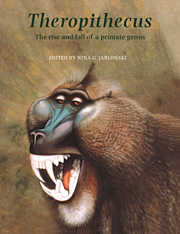Book contents
- Frontmatter
- Contents
- List of Contributors
- Preface
- Acknowledgements
- 1 Introduction
- PART I Fossil evidence and phylogeny
- 2 Theropithecus darti from the Hadar Formation, Ethiopia
- 3 Evolution of Theropithecus in the Turkana Basin
- 4 Are Papio baringensis R. Leakey, 1969, and P. quadratirostris Iwamoto, 1982, species of Papio or Theropithecus?
- 5 Theropithecus fossils from Africa and India and the taxonomy of the genus
- 6 Theropithecus from Ternifine, Algeria
- 7 The Phylogeny of Theropithecus
- PART II Biogeography and evolutionary biology
- PART III Anatomy of the fossil and living species of Theropithecus
- PART IV Behaviour and ecology of living and fossil species of Theropithecus
- Appendix I A partial catalogue of fossil remains of Theropithecus
- Appendix II Conservation status of the gelada
- Index
2 - Theropithecus darti from the Hadar Formation, Ethiopia
Published online by Cambridge University Press: 11 November 2009
- Frontmatter
- Contents
- List of Contributors
- Preface
- Acknowledgements
- 1 Introduction
- PART I Fossil evidence and phylogeny
- 2 Theropithecus darti from the Hadar Formation, Ethiopia
- 3 Evolution of Theropithecus in the Turkana Basin
- 4 Are Papio baringensis R. Leakey, 1969, and P. quadratirostris Iwamoto, 1982, species of Papio or Theropithecus?
- 5 Theropithecus fossils from Africa and India and the taxonomy of the genus
- 6 Theropithecus from Ternifine, Algeria
- 7 The Phylogeny of Theropithecus
- PART II Biogeography and evolutionary biology
- PART III Anatomy of the fossil and living species of Theropithecus
- PART IV Behaviour and ecology of living and fossil species of Theropithecus
- Appendix I A partial catalogue of fossil remains of Theropithecus
- Appendix II Conservation status of the gelada
- Index
Summary
Summary
The well-preserved sample of specimens of Theropithecus darti (Broom & Jensen, 1946) from the Hadar Formation of northeastern Ethiopia makes significant contributions to our understanding of the early evolution of the T. oswaldi lineage and to the initial radiation of the genus Theropithecus.
The Hadar specimens are the first of the species to be associated with radiometrically dated sediments. The age of these sediments indicates that the specimens are between 3.4 and 2.9 Ma old and are, thus, the oldest of the species yet described.
The well-preserved adult male cranial and mandibular specimens allow, for the first time, description of the adult male skull of the species. Characteristics of Hadar males, as well as females, confirm the close relationship of T. darti to T. oswaldi proposed by others based on specimens from Makapansgat in South Africa. The Hadar specimens share with those from Makapansgat a small suite of primitive characters that are used to differentiate the two species and, in conjunction with the derived characters shared with T. oswaldi, indicate an ancestor-descendant relationship between them. The larger size of the specimens from Makapansgat and the occurrence of more derived dental and mandibular characters suggest that they are younger in age than those from Hadar, as does evidence from suid biostratigraphy.
The occurrence of T. darti in the middle Pliocene of East Africa and the late Pliocene of South Africa indicates that the species was probably widely distributed in sub-Saharan Africa during later Pliocene times.
[…]
- Type
- Chapter
- Information
- TheropithecusThe Rise and Fall of a Primate Genus, pp. 15 - 84Publisher: Cambridge University PressPrint publication year: 1993
- 8
- Cited by



